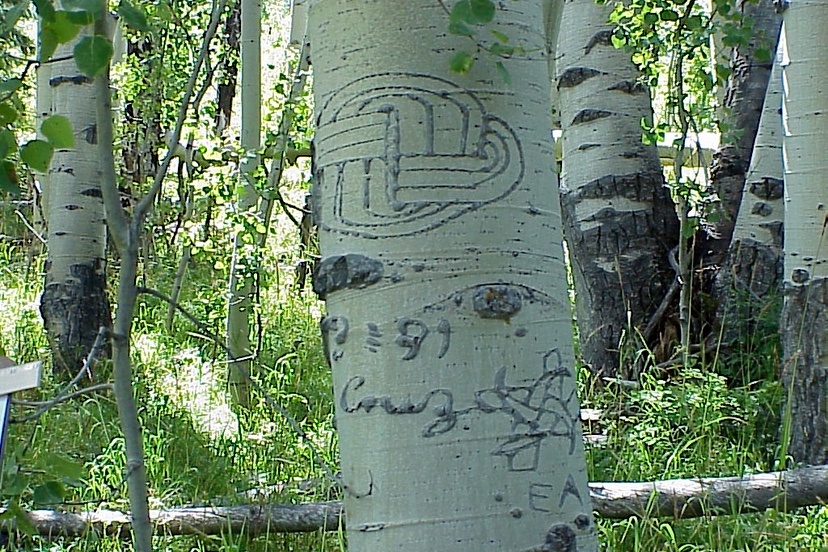Photo: Since the 1970s, Pagosa researcher Peggy Bergon has been documenting aspen tree carvings left by Archuleta County sheepherders. This particular drawing is by Leandro Cruz, dated 1931. Ms. Bergon calls it “one of my favorites”.
The speech delivered Spanish Fiesta Committee member Leonard Martinez, at the dedication of Chad Haspels’ new bronze sculpture, reflected the same research he had shared in a Daily Post article — “Where Have All the ‘Borregeros’ Gone…?” — posted here on July 25.
Much of the story came from Mr. Martinez’ memories of his own family’s involvement in sheepherding in the 1950s and 1960s.
In those days, the sheepherders typically spent the summer months in the high foothills of the San Juan Mountains, where the sheep grazed and the lambs frolicked, typically on Forest Service land. As winter approached, the sheep population had grown and multiplied, and — presumably after being fleeced for their wool — a portion of the sheep where herded into railroad cars on their way to the slaughterhouse. A certain number of sheep stayed behind, to form the core of the next year’s flock.
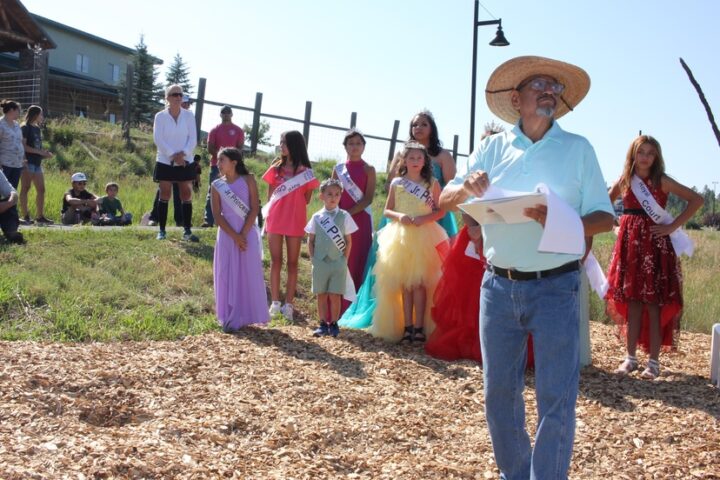
I don’t recall seeing sheepherders in Pagosa Springs when I moved here in 1993, but I eventually heard about the occasionally-violent historical conflicts here, between the Anglo cattlemen and the Hispano sheepmen — disputes based, I must assume, mainly on cultural differences.
The creation and installation of Chad Haspels’ new bronze sculpture came about because, now, those same cultural differences are not only tolerated, but celebrated.
But here’s another aspect to this story, as it relates to our Pagosa culture: Public art…
…another thing I don’t recall seeing when I arrived here in 1993.
“Public art” comes in several flavors.
1. Art in public locations funded by the taxpayers, and typically chosen by an appointed committee that may or may not have the power to define its own budget. In the case of the Town Public Arts Committee, the budget the past few years has been set by Town Council at around $20,000 annually. The Town government justifies this expenditure of public funds for art, partly on the assumption that art makes our community more attractive and thus encourages population growth and increased tourism… both of which result in increased tax revenues for government. (As far as I know, the Archuleta Board of County Commissioners has never expressed an interest in funding public art.)
2. Art in public places funded by non-profit corporations or by private individuals. The new Tennyson Sculpture Park on Lewis Street is an example of this cultural practice; it was privately funded by local resident Evelyn Tennyson to honor her late husband, Mike Tennyson.
3. Sometimes, local government and private entities or non-profits cooperate. The new bronze sheepherder in Aspen Village is an example of such a collaboration, with funding coming from the Town Public Arts Committee, the Pagosa Springs Area Tourism Board, and the non-profit Pagosa Springs Arts Council.
4. Some art gets housed in museums that are open to the public. Typically, museums will showcase art chosen by a trained curator who has opinions about what qualifies as ‘museum quality’.
5. Then we have the ‘unauthorized’ ad hoc art created in public places by individuals. Another name for this is ‘graffiti’. But when it’s been around long enough, it becomes historically important and valuable. For example, the arborglyphs created by Archuleta County sheepherders in the high country forests have been the subject of documentation. Pagosa researcher Peggy Bergon has collected thousands of photos of these aspen tree messages and drawings, and she sent me some of her photos yesterday.

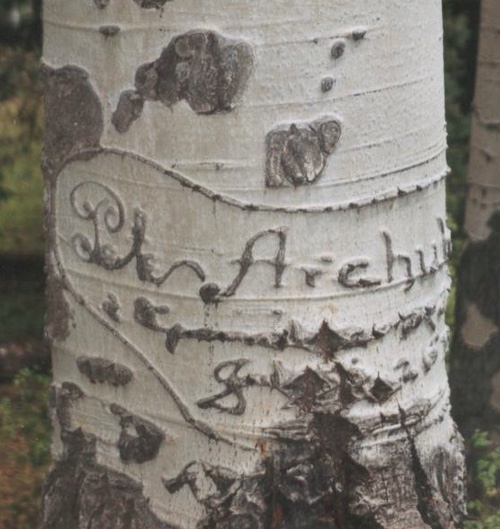
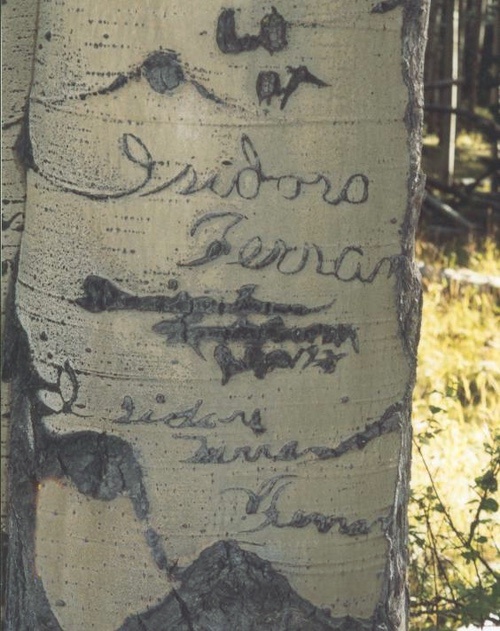
These carvings on aspen trees, on what is now mostly U.S. Forest Service land, could easily be considered ‘graffiti’. Instead, they’re now generally considered “documentation” of the community’s sheepherder culture that thrived during the previous century.
From an article in the Colorado Sun, by Durango historian Andrew Gulliford:
Now fewer and fewer bands of sheep munch on forest grasses, and the herding tradition is declining, as are stands of older aspens. Most of the men are gone now. They went back to their villages and small towns. On winter nights sitting in small kitchens, coffee in hand, they must have looked out their windows and thought of their trees — white in the moonlight, soft and silky to touch, silent except for the rhythmic rustling of leaves. They remembered the incessant bleating of their sheep and the way a herd moves through the forest slowly in a meadow, and faster through the trees like a river flowing around rocks. Finally, the flock beds down for the night, circled by faithful herding dogs.
Shepherds remembered their quiet evenings smoking, carving, dreaming of home. The trees remember. Now we must read the trees to glean and understand a Western tradition that’s almost gone.
The bronze sheepherder who now stands beside the Aspen Village multi-use trail, gazing off into the distance, will serve as another way to help us understand the culture that played a significant role in the social and economic life of Pagosa Springs, not so long ago… before the arrival of the developers, and real estate companies, and tourists, and investors…
He looks lonely, to me.
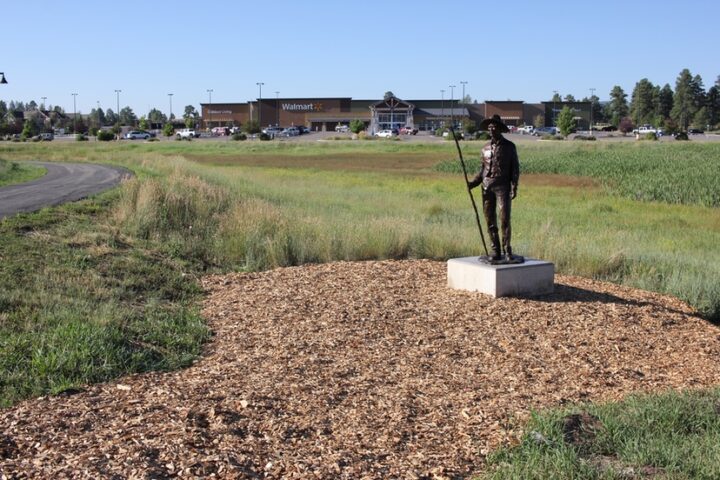
Perhaps the community will come together, in the future, and provide some bronze sheep to keep him company?
A couple of baby lambs?
And a sheep dog, too, would be nice…

